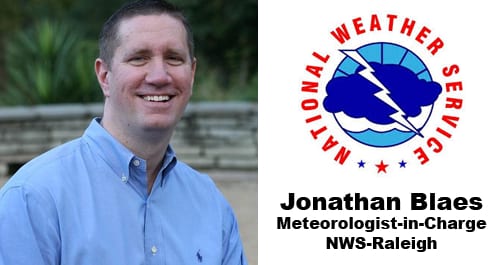They probably don’t teach terms like “crazy hot” in meteorology school, but everyone around here knows firsthand exactly what Jonathan Blaes means when he says those words to describe this summer’s weather.
Blaes, director of the National Weather Service office in Raleigh, summarized the current weather pattern that has sent temps soaring into the triple-digit range across parts of the Midwest and West.
“In Texas and Arizona, it’s been crazy hot without a break for months,” Blaes said on Tuesday’s TownTalk.
North Carolina summers often see stretches of hot weather for days in a row, but not months. “This (pattern) has been pretty persistent and pretty remarkable,” he added.
The thunderstorms that blew through the area earlier this afternoon are ushering in a slight break in the heat and humidity, with predicted highs hovering in the mid- to upper 80’s for the rest of the week.
Heat and humidity are the basic fuel for thunderstorms, Blaes said, so why don’t we have thunderstorms every single day during the summer?
We feel the heat and humidity down here on the ground, but there are other factors that affect the likelihood that afternoon storms will pop up, he explained. Take the temperature of the air at higher elevations, from cloud level and beyond, for example.
Temperatures need to cool off at a steeper rate to fuel storms, so when it’s “hot all the way up into the clouds,” that cooling doesn’t always occur at the rate needed to create storms.
But there are other factors closer to earth that have a bearing on the weather, including soil makeup, elevation and bodies of water, just to name a few.
“Weather is very local,” he said. “Details matter. Locations matter,” he added. “All those different features and materials interact with the air and sunlight and they’re different.” Those differences help to drive the weather patterns in a particular area, both in the short-term and long-term.
And Blaes and his team consider all those factors when they make their forecasts.
The National Weather Service team is keeping an eye out as hurricane season continues. There already have been four named storms, and we’re barely three months in, he said.
The NOAA forecast is calling for above normal activity this hurricane season, with between 14 and 21 named storms.
Typically, we can count on 14 named storms. Of that number half, will become hurricanes. Of that seven, half of those will be Category 3 or stronger, Blaes said.
“Things are going to ramp up and you can place a pretty good wager we’re going to be hearing more about tropical storms in the Atlantic,” he said.
Thanks to sophisticated technology advances, forecasts are more data-driven and less prediction or educated guesses.
In the event of a hurricane between now and November, Blaes said one thing he’d for sure recommend is to prepare a hurricane kit and make a plan. Just in case.
CLICK PLAY!
